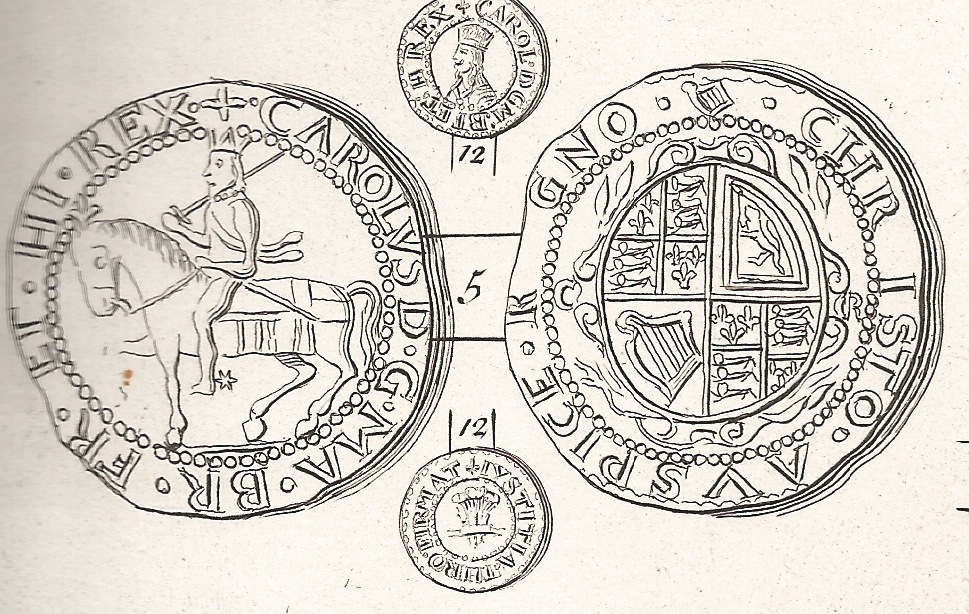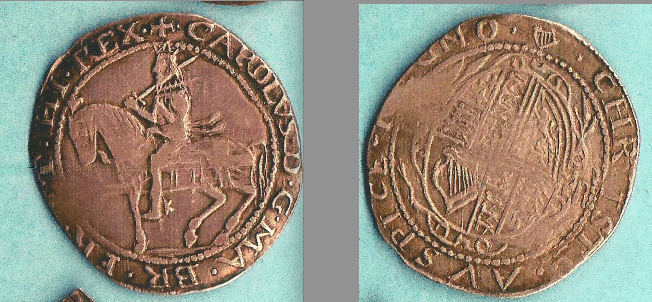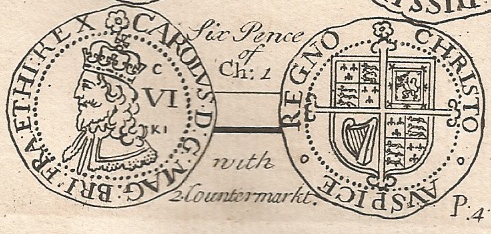
kal
Unidentified Variety-
Posts
59 -
Joined
-
Last visited
-
Days Won
2
Content Type
Profiles
Forums
Events
Downloads
Store
Gallery
Articles
Everything posted by kal
-
It is my understanding that the King left Newark on 3 Nov, 1645, a few weeks prior to the arrival of the main Scottish and Parliamentary armies on 26 Nov. Then a close siege of the city began and there was little likelihood of relief from then onwards. The siege pieces were most likely produced between this time and May 6, 1646, when Lord Belasyse was ordered to surrender. The coins themselves for the most part were directly cut from the available silver plate. The halfcrown denomination requiring a thick flan were produced from prepared silver sheets in turn sourced from melting down stems, handles, etc. REF. H.R. Jessop S.N.C. March 1976: "Flans for Newark Siege Coins". The Carlisle and Pontifract pieces were likewise made from melted down silver plate. In the case of Carlisle, 86 oz or 7.4% was lost in the melting and refining process. As for the Ormond series, I agree that they were not produced under siege conditions; that is why I used the term "Money of Necessity" in reference to them.
-
Hi Garrett, I agree silver is silver, but I believe siege coins/money of necessity issued under the authority of local governors were not intended to circulate outside the confines of the strongholds or the town under siege. Both Carlisle and Pontefract issues were intentionally produced underweight in order to stretch out a limited supply of plate. Only in Newark was the weight consistently maintained. The Irish Ormond issue was an exception. King Charles I directed Ormond to negotiate a truce with the Confederate Catholic Assembly in order to free up troops that then could be deployed in England and North Wales. To facilitate this, he, by Royal Proclamation directed in May 1642 that the' loyal subjects' in Dublin bring in their plate to be coined to the same standards of weight and purity "as are moneys now current in England". The King also directed that the Royal Cypher C.R. beneath the crown be displayed the observe and the nominal value on the reverse.
-
Both these examples were issued in Dublin by order of the Lord Justices during the Irish Rebellion. The rare shilling of January 1642 is from the first issue and normally is referred to as "Inchiquin money". Its weight is expressed in Arabic numerals, penny weights and grains. The halfcrown known as "Ormond money" is from a much larger issue of July 1643, and shows the value in Roman numerals. This coinage was surprisingly declared legal tender in England and Wales and sometimes examples turn up in Civil War hoards.
-
Hi Peter, LOL. I wondered if it was a tongue-in-cheek comment but wasn't sure - it always takes a while for the penny to drop in my case I'm presently doing research on the "uncertain castle" pieces, inquiring of museums their numbers and denominations and will post the info when able. Do you have any knowledge concerning this series?
-
Thanks for the comments. Peter - not sure what you mean - posted on forum. These are not quite as choice but the "uncertain castle" piece is extremely rare.
-
Sometime back "TomGoodheart' asked if I could post some images. Having recently obtained a decent micro lens, here are some of my better pieces.
-
It is plausible that other denominations were struck and have not been recorded. Are you able to post an image?
-
Nice coin. It's always good to match these up to old drawings as a little artistic license was usually employed. This series has a way to go yet, with hitherto unrecorded denominations. Hi Rob, It's one of a very few Irish coins I have retained. Your reference concerning other denominations of this series is interesting. Unlike the Lords Justices of Dublin representing the protestant royalists who produced a fairly extensive range of values, i.e., "Inchiquin" and "Ormond" money, Kilkenny money is only known for a silver issue of half crowns and a copper issue of half pence and farthings, the latter struck in quantity from a supply of 4,000 lbs of red copper. Both these were coined by an Order of Council in Kilkenny and dated 15 October, 1642. These are similar in design to the English model - the Tower half crown for the blacksmith and the copper imitative of the Richmond/Maltraver issues, although cruder and struck on much larger flans. It seems remarkable that war could be waged on the basis of these irregular and limited coinages, but hoard evidence suggests large quantities of foreign money was in circulation in Ireland at this time, notably from both Spain and France.
-
This coin illustrated on plate 14, item 13 of “A View of the Silver Coinage of England” is listed under unknown mints and referred to as “Amongst the very great variety of this King’s money, altho’ we meet many very rude, and of bad workmanship, yet we think none of them comes up to the halfcrown No 13, the barbarous work of which was certainly that of a smith and not of an engraver.” This coin engraving is also used by martin Folkes in ‘Table of Silver Coins,… Plate XXVI, Fig 5 in 1763. - These plates were prepared before his death in 1754. Ruding in the following century republished the Folkes’ plates, in the three editions of his work. Although now commonly referred to as the ‘Blacksmith’s halfcrown’, in 1861, Aquilla Smith assigned this piece to Ireland’s Rebellion necessity series and specifically to the Confederate Catholics in Kilkenny circa 1642. I believe the coin is identifiable by the weak striking of the horse’s raised foreleg, and the unusual reverse decoration of ‘wheat ears’ or as Maurice Bull describes them, three lilly buds, upper left and right on reverse. (Bull 19A, Rev 2). The coin’s known provenance is Marsham, Murdoch, Hilton-Price, and Lockett. In the Lockett catalogue June1957 this piece is described as “Reputed to be the finest known example of this ill-struck series, very rare”.
-
Literature recommendations
kal replied to TomGoodheart's topic in British Coin Related Discussions & Enquiries
If you extend the time frame a little, say to post war you could then include Paget 1946, Nightingale 1951, and Lingford 1950, probably among the best crown collections ever assembled. -
Hi Matteo95 I collected groats in the mid-eighties concentrating mainly on Henry VII/VIII. Then, although a fairly regular Spinks customer, I never managed to obtain a much sought after piece, Henry VIII 2nd coinage groat with Laker bust A with Roman lettering, Lot 210 in this collection! Too late now, I've moved on. With regards to obtaining a catalogue, unless you are a subscriber or a potential customer known to them, I think it's doubtful they will send them free. One option is to download a PDF either from their site or numisbids.com. Having said this, nothing to lose by sending a request via e-mail.
-
A comprehensive collection of groats, Medieval and Tudor including many very rare examples with important pedigrees are on offer. In my opinion, the sale is conservatively graded and well illustrated. The coloured plates where all the lots are on display are particularly good. Even when compared to other specialized groat sales, e.g., Brady, Buck or Gilboy, this collection is impressive.
-
-
On closer examination of the Pembroke engraving it indicates two countermarks - the addition of the letter "C" above the mark of value. Even allowing for the lack of accuracy in these plates, the K1 shows no similarity with the previous examples mentioned. The sixpence to me resembles a Briot first milled issue IM flower/daisy with an abbreviated obverse legend, the reverse showing, a Cross Moline over square top shield, but again with IM flower/daisy? I can't think of a valid reason to add these stamps as they greatly devalue the coin.
-
Update: While looking through part 4 of "Numismata Antiqua", "Illustrated Catalogue of The Earl of Pembroke's Collection, 1746", I noticed on plate P4 T9 an illustration described as "Sixpence of Charles I with countermark" with the letters K1 below the mark of value. There was no additional descriptive text but the collection was sold at auction on July 31, 1848 by Sothebys.
-
Paulus, The Frank Brady collection, Spink, Oct, 2011, is a good reference for this series. Both issues are well illustrated. Besides the number of bands, the King's portrait is noticeably different. This King's "regular" profile continues in use during the Henry VIII first coinage, 1509 -1526.
-
Henry vii Tentative issue groats are all rare according to North.The 'Septim' variety has only two examples known and of the 'Tressure of arches on obverse' type only four are believed to exist.The 'regular' issue,with the triple band to the crown is the most often seen.
-
Previewing "British coins from various properties", a Charles II 'six pence' third hammered issue, struck on a thick flan, had a counter stamp which I thought familiar. The coin is described as "with part of a hallmark stamped in front of face". I found intriguing the footnote suggesting a metal trial independently stamped with a silversmith's mark. This is the same stamp (KI within a shield-shaped indent) which is punched below the date of a Newark siege shilling of 1646 illustrated in Patrick Finn's list #15, 1999. Patrick also notes the existence of an Ormond six pence (1643) counter-stamped on the reverse from the same punch. This coin now resides in the the B.M. It has been suggested, both by Nelson 1905 and more recently Finn, that the KI was a countermark used by the Confederate Catholics in Kilkenny during the Great Rebellion. With the appearance of the DNW six pence coined early 1662, that theory no longer seems credible.
-
IS THIS RARE AND IMPORTANT IRISH GOLD PIECE OF NECESSITY WITH LIMITED
kal replied to kal's topic in British Hammered
Thanks for posting a photo of the piece,and the comments Very few examples of Obsidional /necessity money can be described as appealing, not surprising considering the conditions under which they were made.This Pistole like its predecessors the "Inchiquin "silver issue are particularly crude,displaying only a stamp giving its weight in penny weights and grains. Their historical context is considerable; the double Pistoles are especially rare as only two examples survive, now both in National museums. I would consider them as equally important and as rare as the Scarborough pieces in the English siege series. -
In the upcoming CNG auction, the Dr. Lawrence A. Adams Collection, in the British gold section, is offered a very rare Irish gold coin or pledge. This emergency issue by Ormonde in 1646, if authentic, brings the total extant to twelve and thereby increases the number available to collectors from 2 to 3. This example, Lot 2751, appears to be unusually well struck and, condition wise, far superior to the recent Bullmore or Brady examples that sold in April 2000. The origins of these important coins, being the only Irish gold issue, are fairly well documented. Other than the four pieces from the contemporary Bridgewater House collection, which contained two extremely rare double pistoles and two single pistoles, the six discovered in the Portarlington hoard, 1946, and the single examples in the Carruthers and Aquilla Smith Collections leave one of the two examples in the Chapman cabinet as a possible candidate. In 1850, James Carruthers, a Belfast collector, wrote “About this time five similar coins were discovered: two of which are in the British Museum, two in the cabinet of Sir Montague Chapman and the other belonging to Dr. Aquilla Smith of Dublin. The two in the B.M. are from the Bridgewater House Collection, deposited for safe keeping, one of which is now in the Ulster Museum. the other example in the Brady sale and more recently La Rivere Spink 2006. The A. Smith coin now resides alongside the Portarligton hoard in the Irish National Museum Dublin. A Chapman example ended up in the American Numismatic Society via Murdoch, Brand and Norweb. The Carruthers coin, procured from the locality of Belfast in 1839, was mistakenly and tragically described as false in the Sotheby sale, January 1857, and accordingly sold for a pittance, its present whereabouts unknown. It may have been condemned because a number of Inchiquin silver counterfeits were also present in his collection. The Adams pistole now on offer may possibly be the other example mentioned by Carruthers, and was probably sold prior to the Chapman sale, Sotheby December 1894.
-
Civil War Coinage....extraordinary.
kal replied to Danelaw's topic in British Coin Related Discussions & Enquiries
Hi David, I would also grade the penny as good very fine.My point concerning lot #3622 is the original grade of very good (fair) might be stretched to near fine with a large helping of wishful thinking, but to grade the piece as almost very fine is inexplicable. My experience with Spink and their grading, especially at auction is they tend to be conservative and sometimes under grade. -
Civil War Coinage....extraordinary.
kal replied to Danelaw's topic in British Coin Related Discussions & Enquiries
"Ashmore Replicas- Revisited" by Patrick Finn S.N.C. april 2000.covers these items in detail including illustrations as available. On the subject of siege coinage what I find alarming is the condition creep evident in the upcoming Baldwin auction #96 lot 3362 the Carlisle three shilling piece described "raised die flaw on reverse, weak at centre,almost very fine for issue"The Bridge Water House description of this coin lot #301 also notes the die flaw but adds "otherwise very good". Another if less obvious instance of grading creep was the Magnus sale example of a Carlisle three shillings lot #960 described by Spink as about very fine, this same piece later offered by Baldwin as good very fine for issue. The buyer I know ultimately will use his own judgement,both regarding the grade and if "for issue"is just hyperbole. Any thoughts? -
Hi Tom, Like most collectors, after a few false starts collecting medieval groats, then hammered crowns, I finally ended up collecting civil war siege coins, both English and Irish, all the while adding coin books and auction catalogues, but to be honest, always reluctant to spend much on reference material. Buying early Sotheby catalogues and very fine Charles I silver 30 years ago was affordable. Today I am content obtaining the odd catalogue when they come available.
-
With reference to forgeries and the civil war siege issues,we are fortunate that the two most skilled counterfeiters Emery and Singleton both active in early Victorian times seem to have concentrated their efforts on different numismatic periods namely Anglo-Saxon, Norman and Tudor. Emery by far the more skillful also liked to fabricate rare Irish and Scottish coins again targeting the Tudor period. John White a mid eighteenth century forger described by Michael Dolley as"author of a number of extremely ingenious forgeries of Anglo-Saxon and early medieval series".White also a dealer,supplied some of coins that ended up in the Hunter collection.The two "Scarborough type 1{Hunterian] both likely struck from the same plate{displaying similiar edge marking}, described in the Slaney review"shallowly engraved, weakly struck and blurred suggesting that the punch was difficult to impress".These two pieces I believe are possible candidates of Whites work?That they are based on the B.M. specimen and its die pair Slaney#359 indicates to me that the latter two are maybe genuine both originally made on larger flans before being severely cut down ,more so #359. Thanks Tom, When active ,over twenty years ago, I assembled a small collection of English and Irish siege coins. I now collect numismatic books and early coin auction catalogues.
-
Setting aside eighteenth century concoctions, and outright fakes for example the three "Singletons"referred to in the recent Spink Slaney review.Asigning the Type 1 to an unrelated issue and placing the contemporary Type 111 "uncertain castle"series to a different location, we are left with Type 11. In the recent Spink Magnus auction in 2012 lot # 963 is described two shillings and tenpence Type 11"without doubt from authentic Scarborough punches" and continues "which are accepted as those used for coins during the siege".I estimate there at present is twenty two examples existing,published with illustrations from various sources mostly museums and auction catalogues.They range from the five shilling and eight pence (Hunterian} to the fourpence B.M.They are all produced from the same set of punches referred to above.






